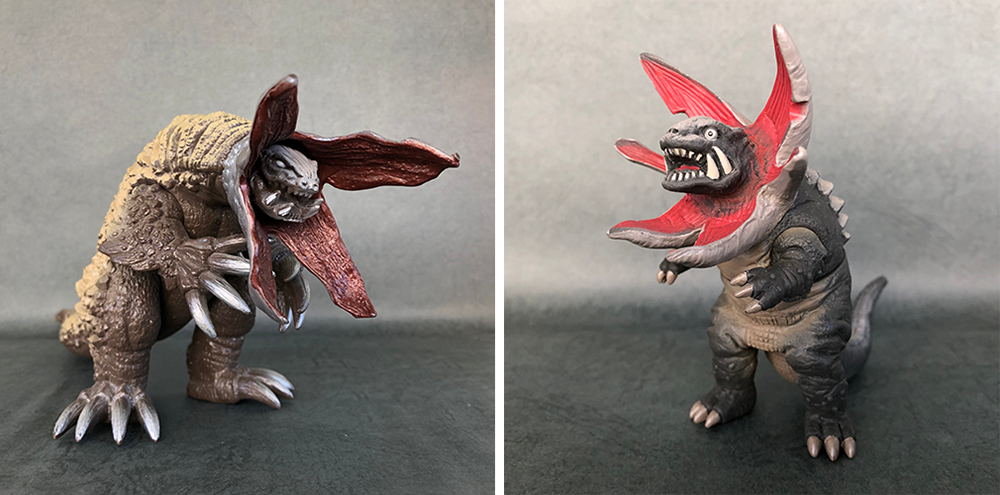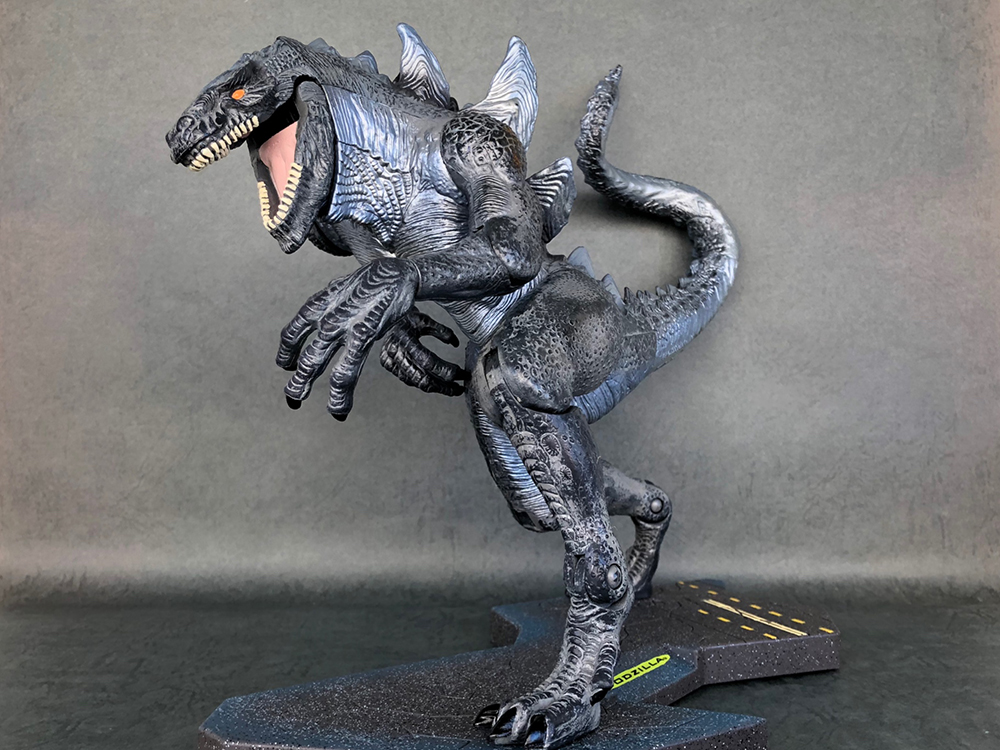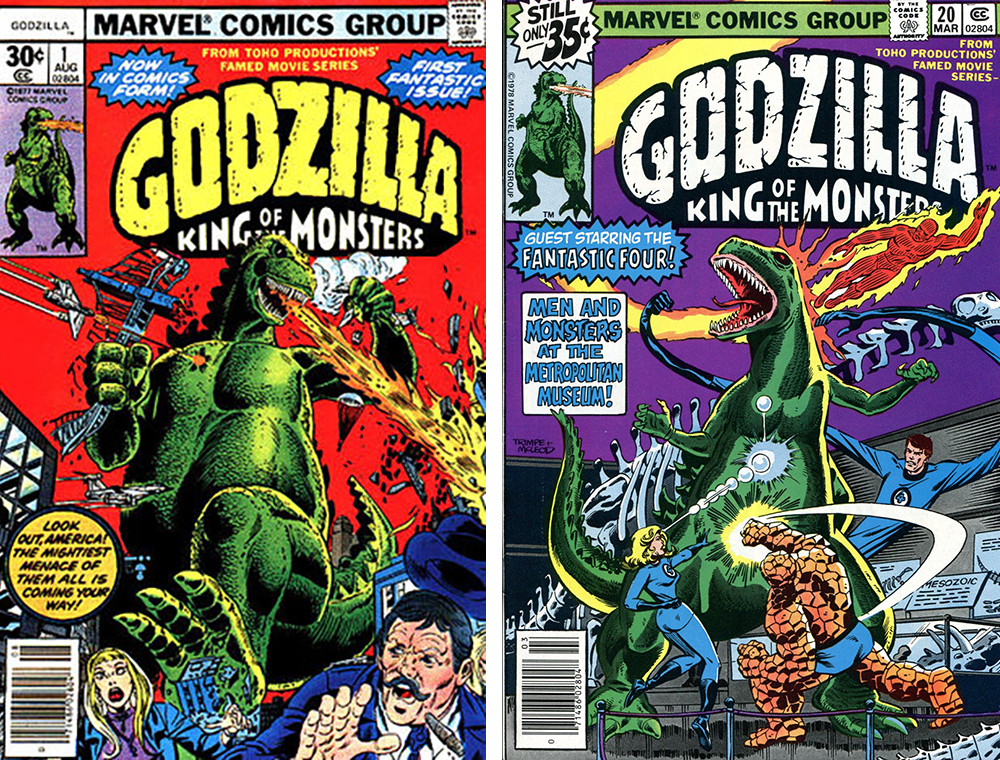Godzilla has a star on the Hollywood Walk of Fame. Godzilla is the only Japanese fictional character ever honored with a star on the famous sidewalk. Gamera, Ultraman, and Kamen Rider made a foray into overseas market. Super Sentai (superhero team), known as Power Rangers was a great success. However, they haven’t got stars on the Walk. What does Godzilla mean to Americans?
 Left: Uranium monster Gabora from Ultraman Powered (1993), Right: Uranium monster Gabora from Ultraman (1966). Ultraman Powered is a sort of remake of the original Ultraman. Many familiar characters, such as Alien Baltan and Zetton, appeared in the show. Those Ultraman Powered monsters redesigned by Mahiro Maeda known for the design works for the Heisei Gamera series, Neon Genesis Evangelion (1995) and Mad Max: Fury Road (2015) are reminiscent of the times when SFX was at its zenith.
Left: Uranium monster Gabora from Ultraman Powered (1993), Right: Uranium monster Gabora from Ultraman (1966). Ultraman Powered is a sort of remake of the original Ultraman. Many familiar characters, such as Alien Baltan and Zetton, appeared in the show. Those Ultraman Powered monsters redesigned by Mahiro Maeda known for the design works for the Heisei Gamera series, Neon Genesis Evangelion (1995) and Mad Max: Fury Road (2015) are reminiscent of the times when SFX was at its zenith.
*All the figures shown in the photographs are the author’s personal properties.
American-born Ultraman
In the 1980s, once-prospering Japanese special effects TV series were experiencing a decline in number. Only the Super Sentai series starting with Himitsu Sentai Gorenger (internationally known as Five Rangers) (1975) and the Metal Hero series beginning with Uchu Keiji Gyaban (also known as Space Sheriff Gavan) had new series produced every year. In other words, except for those two series, no SFX shows were aired. Most antagonists in those works were human-sized “Kaijin” and they did not fit the definition of “Kaiju” proposed in this article (*1). No new episodes of the “Ultraman” series, the leader of the Kaiju SFX, were produced after Ultraman 80 (1980) and a spin-off Andro Melos (1983). However, that didn’t mean that Ultraman no longer attracted children. PVC figures still filled the shelves of toy stores and films made up of highlights of past series with some newly filmed footage and TV shows using past videos continued to be produced. In 1989, a completely new film was released at last. It was Ultraman: The Adventure Begins (*2).
Ultraman: The Adventure Begins was a fulllength animated film co-produced by Hanna-Barbera Productions, a long-established animation studio in the United States, and Tsuburaya Productions. The animation was created mainly by Japanese animation studios. The screenplay was written by a U.S. writer. The story was about three Ultra warriors merged with the U.S. Air Force air demonstration squadron members fighting against space monsters from the planet Sorkin (*3). The film was first aired as a made-for- TV movie in 1987 ahead of Japan. Although it didn’t spawn a TV series, it reportedly garnered third highest ratings in the category of made-for-TV kid movies.
As finding possibility in overseas market, Tsuburaya Productions planned a project of a live-action film set in Australia. The project fell through. However, the project was combined with a stalled plan for a new TV series “Shin Ultraman” into a 13-episode video series. It was Ultraman Great (1990) co-produced with Australia. Based on the basic setting, design and original screenplay prepared by the Japanese team, South Australian Film Corporation run by South Australian Government produced the show. The whole cast were non-Japanese. The designs and forms of the Kaiju characters were more like those of animals or something that the term “creature” would fit. Some of the approaches made in the series were characteristic of overseas special effects crew, which audience might find amusing. For instance, a gigantic puppet was used for a four-footed monster difficult for a suit actor to play. Outdoor sets were frequently used, making the most of the vast land of Australia. The whole show was exactly what overseas TV dramas would look like. The series also got high ratings on a cable TV channel in the United States. The ratings were higher than those the original Ultraman scored in the United States. That led the Ultra series to go on the U.S. mainland again. It was the Ultraman Powered, a big project outsourced to Hollywood film crew.
Just like Ultraman Great, Ultraman Powered was produced with its fundamental parts, such as setting, screenplay and design work, done by the Japanese studio. The U.S. was definitely a major superhero film and TV maker more than Japan, but few giant heroes like Ultraman had been produced before. It must have been difficult for the U.S. crew to understand the world view. Similarly, during the production of Ultraman: The Adventure Begins, the Ultra warriors Hanna-Barbera first proposed wore a cape. It is said that Americans couldn’t accept a hero flying without a cape (*4).
In 1993, Mighty Morphin Power Rangers, the localized English version of Super Sentai series Kyoryu Sentai Zyuranger (dinosaur squadron beast ranger) (1992) started to be aired in the United States. This show was a social phenomenon. It garnered the highest ratings ever in the history of the U.S. children’s TV series (*5). The “Power Rangers” series is a smash hit still on the air. By contrast, Ultraman Powered failed to win such great popularity. After all, American children seem to be more familiar with human-sized heroes. Among the Super Sentai series merchandise in Japan, Gattai Robo (combining robot) toys are the most popular. As for the “Power Rangers” series, the top favorites are vehicle toys including motorbikes. It seems that the Japanese people love giant characters, such as giant monsters, giant heroes and giant robots. The likes and tastes do not always match the global standard. However, the Kaiju culture is exceptionally accepted for some reason.
Kaiju in the United States
 Godzilla from Godzilla (1998). Its upper body was similar to that of a human. That, according to the designer Patrick Tatopoulos, was one of the techniques to keep the Godzilla-ness, typical characteristics of Godzilla. Godzilla-ness, in other words, may be Kaiju-ness. The pointed dorsal fins like that of a shark were later adopted in Japanese Godzilla.
Godzilla from Godzilla (1998). Its upper body was similar to that of a human. That, according to the designer Patrick Tatopoulos, was one of the techniques to keep the Godzilla-ness, typical characteristics of Godzilla. Godzilla-ness, in other words, may be Kaiju-ness. The pointed dorsal fins like that of a shark were later adopted in Japanese Godzilla.
In Part 1, I touched on the remake of Godzilla released in 1998. Unlike the overseas versions of Ultraman above, it was an out-and-out Hollywood big movie. This film was surprisingly faithful to the original Godzilla (1954) at the beginning but it showed great originality in the unfoldment of the story, the appearance of Godzilla and the setting. The film provoked a backlash from Godzilla fans at home and abroad. This article is not a film review and therefore I won’t go into detail about the criticism (*6). It, however, is noteworthy that the Hollywood remake version Godzilla met with a negative reaction from not only Japanese people accustomed to the conventional Godzilla but also quite a few Americans. The fans in other countries far away from Japan also had their ideal image of Godzilla, i.e., what Godzilla should be like. How did the king of the monsters become beloved so much?
Godzilla films used to be bought cheaply by American International Pictures and other film distribution companies and shown at small local cinemas as part of a double feature, suburban drive-in theaters or on TV during a time slot for B-movie, such as Saturday afternoon and midnight. Godzilla was popular among American teenagers. Particularly in the 1960s to ’90s, it was so popular that Godzilla films were aired on some TV channel or another every week (*7). Godzilla films familiar to American audience were not always faithful to the originals. Sometimes they were dubbed excessively humorously, conference scenes or those considered boring for children were cut or new scenes were added. As for Godzilla, King of the Monsters! (1956), the overseas version of the first “Godzilla,” all the scenes that depicted the U.S. negatively, such as nuclear development and World War Two, were either eliminated or made inconspicuous. If any non-Japanese knows Godzilla’s background of being the spawn of nuclear development, he or she must be a hardcore fan.
In the animated TV series Godzilla: The Series (1999), a sequel to the remake of Godzilla, Godzilla was depicted as a hero. Godzilla junior believed a human as its parent by imprinting and it fought against mutant monsters and aliens across the world. Similarly in the TV animation version of Godzilla (1978) produced by Hanna-Barbera Productions, Godzilla traveling with the marine science research vessel Calico, together with its nephew Godzooky, fought against vicious monsters. Those characters must have reflected the image of Godzilla in the 1970s, which was fighting for justice (*8).
 Left: Front cover of the first issue of Godzilla, King of the Monsters (1977)
Left: Front cover of the first issue of Godzilla, King of the Monsters (1977)
Right: Front cover of the 20th issue of Godzilla, King of the Monsters (1979)
In the Godzilla, King of the Monsters published by Marvel Comics for about two years from 1977, Godzilla would never align itself with humans and rampaged as a savage gigantic monster. It waged fierce battles against the Fantastic Four and the Avengers. Incidentally, DC Comics also had Batman fight against a monster called Babonga in 1956. Babonga was a cross between Rhedosaurus from The Beast from 20,000 Fathoms (1953) and Godzilla. There is a common notion that only human-sized heroes appear in American comics. In actual fact, not a few American comics feature monsters. Especially Marvel Comics had giant monsters appear in anthologies of sci-fi comics in the late 1950s when the popularity of super hero comics was waning. Those monsters had names containing a dull sound, such as Orrgo, Googam and Gorgilla. They were apparently influenced by the names of Japanese Kaiju (*9). Dark Horse Comics in the 1990s and IDW Publishing in the 2010s published their original stories of Godzilla comics. Dark Horse Comics also published comics of Gamera. Godzilla was not the only Kaiju that went abroad.
Godzilla and other Kaiju characters have become familiar to Americans more than many Japanese imagined. Of course, not all those Americans are passionate Kaiju fans and their image of Kaiju may not exactly match the image Japanese people have. It is at least an undeniable fact that Kaiju is now a part of American pop culture. Just studying the history of cinema won’t tell you that. In the next part, we will look at the world of films again. In that final part, I am going to highlight Kaiju characters that have appeared across the world as if responding to the two return of Godzilla.
(notes)
*1
The fourth Metal Hero series Kyoju Tokuso Juspion (Space Wolf Juspion) (1985) exceptionally featured a giant monster called “Kyoju” in every episode. The series was a massive hit in Brazil. Production of a Brazilian remake film was announced.
*2
In Japan, the film was screened with Episode 20 Terror on Route 87 of Ultraman, Episode 5 Giant Ant Choju vs Ultra Brothers of Ultraman Ace and an animated short film Ultraman Kids as part of the Ultraman Festival.
*3
Those space monsters called Sorkin Monsters included Green Shocks, a plant monster walking with the numerous tentacles, Garuballade, a machinery monster having a body resembling a plasma ball, and King Myra repeating transformation from the initial form like a small animal and finally expanding several times as large as the Ultra warriors. Those monsters was difficult to create by the special-effects technology of that time but possible by animation.
*4
Superman and Mighty Thor do not depend on their capes to fly. There are also American comic heroes flying without a cape, including Iron Man.
*5
After the success of Mighty Morphin Power Rangers, followed VR Troopers (1995) using footage of Metal Hero series Jiku Senshi Spielban (Dimensional Warrior Spielban) (1986), Chojinki Metalder (Superhuman Machine Metalder) (1987) and Space Sheriff Shaider (1984); Saban’s Masked Rider (1995) based on Kamen Rider Black RX (1988); Superhuman Samurai Syber Squad (1994), a localized version of Denko Chojin Gridman (Gridman the Hyper Agent) (1993) produced by Tsuburaya Productions. All those series were combinations of existing action and special-effects scenes with newly filmed dramas in the United States. In the recent “Power Rangers” series, more and more special-effects scenes are newly created and they are now amusing audience as totally different shows from the original series.
*6
Besides the appearance not remotely resembling the original, it was criticized for the features far from Godzilla-ness: It ran at 480 kilometers an hour, didn’t unleash an atomic heat beam, multiplied rapidly and got killed by conventional weapons.
*7
Godzilla, now popular in the United States, has been featured in many TV commercials just as in Japan. Nike and Dr Pepper ads using newly made Godzilla suits and miniature sets are particularly famous. The suffix “-zilla” meaning gigantic and vicious is widely used in the advertising industry. One of the examples is “Mozilla Firefox,” a web browser commonly used in many countries including Japan.
*8
Godzilla made its debut as a threat to humans but depicted more and more baby-faced each time it was filmed. In “Chikyu Kogeki Meirei: Godzilla vs Gaigan (Godzilla vs Gigan)” (1972), Godzilla definitely became a friend of humans. However, when returning for the first time in nine years in Godzilla (1984), Godzilla was a threat to humans again. Since Heisei VS Series, a sequel to Godzilla, Godzilla has established a dexterous standing position. It is depicted as a villain in the films but it is a hero from the audience’s viewpoint.
*9
In the United States, few monsters have their own names in the first place. If a monster looks like a dinosaur, it is called dinosaur. If it is like a bird, it is called a bird or a monster bird. Kong in King Kong (1933) is a rare exception. On a side note, a tree-like humanoid Groot, given great visibility by Guardians of the Galaxy (2014), is one of the monster characters created in the late 1950s. The original Groot was bigger and was a villain.
| ◀ No. 2 | No. 4 ▶ |











